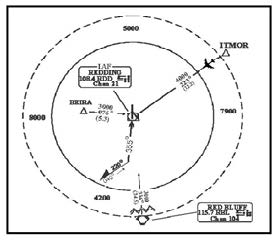PHRASEOLOGY-
- Left 360 , 34Y
Cessna 34Y,, Turn left heading 090
- Left 090 , 34Y
Cessna 34Y, You are 11 miles from RUKIY
Turn right heading 160
Maintain 3,000 until established on localizer
Clear ILS Runway 18 approach
- Right 160,
- maintain 3,000 until establish on localizer
- Clear ILS Runway 18 approach
34Y
Have a good day
- Tower 119.3 34Y good day
----- TRANSITION FROM APPROACH TO TOWER -----
----- TRANSITION FROM TOWER TO GROUND -----
Descend Checklist (Weather, NOTAMS,
Approach
Tower
Ground
CLEARED (type) APPROACH.
CLEARED APPROACH.
(To authorize a pilot to execute his/her choice of instrument approach),
CLEARED (specific procedure to be flown) APPROACH.
(Where more than one procedure is published on a single chart and a specific procedure is to be flown),
CLEARED (ILS/LDA) APPROACH, GLIDESLOPE UNUSABLE.
(To authorize a pilot to execute an ILS or an LDA approach when the glideslope is out of service)
CLEARED LOCALIZER APPROACH
(When the title of the approach procedure contains “or LOC”)
CANCEL APPROACH CLEARANCE (additional instructions as necessary)
(When it is necessary to cancel a previously issued approach clearance)
EXAMPLE-
“Cleared Approach.”
“Cleared (V-O-R/I-L-S/Localizer) Approach.”
“Cleared L-D-A Runway Three-Six Approach.”
“Cleared Localizer Back Course Runway One-Three Approach.”
“Cleared (GPS/RNAV Z) Runway Two-Two Approach.”
“Cleared BRANCH ONE Arrival and (ILS/RNAV) Runway One-Three Approach.”
“Cleared I-L-S Runway Three-Six Approach, glideslope unusable.”
“Cleared S-D-F Approach.”
“Cleared G-L-S Approach.”
NOTE-
- Clearances authorizing instrument approaches are issued on the basis that, if visual contact with the ground is made before the approach is completed, the entire approach procedure will be followed unless the pilot receives approval for a contact approach, is cleared for a visual approach, or cancels their IFR flight plan.
- Approach clearances are issued based on known traffic. The receipt of an approach clearance does not relieve the pilot of his/her responsibility to comply with applicable Parts of Title 14 of the Code of Federal Regulations and the notations on instrument approach charts which levy on the pilot the responsibility to comply with or act on an instruction; for example, “Straight-in minima not authorized at night,” “Procedure not authorized when glideslope/glidepath not used,” “Use of procedure limited to aircraft authorized to use airport,” or “Procedure not authorized at night” or Snowflake icon with associated temperature.
- In some cases, the name of the approach, as published, is used to identify the approach, even though a component of the approach aid, other than the localizer on an ILS is inoperative.
- Where more than one procedure to the same runway is published on a single chart, each must adhere to all final approach guidance contained on that chart, even though each procedure will be treated as a separate entity when authorized by ATC.
- The use of alphabetical identifiers in the approach name with a letter from the end of the alphabet; for example, X, Y, Z, such as “HI TACAN Z Rwy 6L or RNAV(GPS) Y Rwy 04”, denotes multiple straight-in approaches to the same runway that use the same approach aid.
- Alphabetical suffixes with a letter from the beginning of the alphabet; for example, A, B, C, denote a procedure that does not meet the criteria for straight-in landing minimums authorization.
- 14 CFR Section 91.175(j) requires a pilot to receive a clearance to conduct a procedure turn when vectored to a final approach course or fix, conducting a timed approach, or when the procedure specifies “NO PT.”
- An aircraft which has been cleared to a holding fix and prior to reaching that fix is issued a clearance for an approach, but not issued a revised routing; that is, “proceed direct to....” may be expected to proceed via the last assigned route, a feeder route (if one is published on the approach chart), and then to commence the approach as published. If, by following the route of flight to the holding fix, the aircraft would overfly an IAF or the fix associated\ with the beginning of a feeder route to be used, the aircraft is expected to commence the approach using the published feeder route to the IAF or from the IAF as appropriate; that is, the aircraft would not be expected to overfly and return to the IAF or feeder route.
- Approach name items contained within parenthesis; for example, RNAV (GPS) Rwy 04, are not included in approach clearance phraseology.
- Pilots are required to advise ATC when intending to apply cold temperature compensation to instrument approach segments. Pilots must advise ATC of the amount of compensation required for each affected segment on initial contact or as soon as possible. Pilots are not required to advise ATC when correcting on the final segment only. Controllers may delay the issuance of an approach clearance to comply with approved separation requirements when informed that a pilot will apply cold temperature compensation (CTC). Pilots will not apply altitude compensation, unless authorized, when assigned an altitude prior to an approach clearance. Consideration should be given to vectoring aircraft at or above the requested compensating altitude if possible. This eliminates pilots having to climb once on the approach.
- There are some systems, for example, Enhanced Flight Vision System (EFVS), which allow pilots to conduct Instrument Approach Procedures (IAP) when the reported weather is below minimums prescribed on the IAP to be flown.
REFERENCE-
FAA Order 8260.3, United States Standard for Terminal Instrument Procedures (TERPS).
P/CG Term - COLD TEMPERATURE COMPENSATION.
AIM, Para 5-1-17, Cold Temperature Operations.
AIM, Para 5-5-4, Instrument Approach.
REFERENCE-
14 CFR § 91.175(l).
P/CG Term - EFVS.
- For aircraft operating on unpublished routes, issue the approach clearance only after the aircraft is:
- Established on a segment of a published route or instrument approach procedure, or (See FIG 4-8-1)
EXAMPLE-
The aircraft is established on a segment of a published route at 5,000 feet. “Cleared V‐O‐R Runway Three Four Approach.”



No comments:
Post a Comment